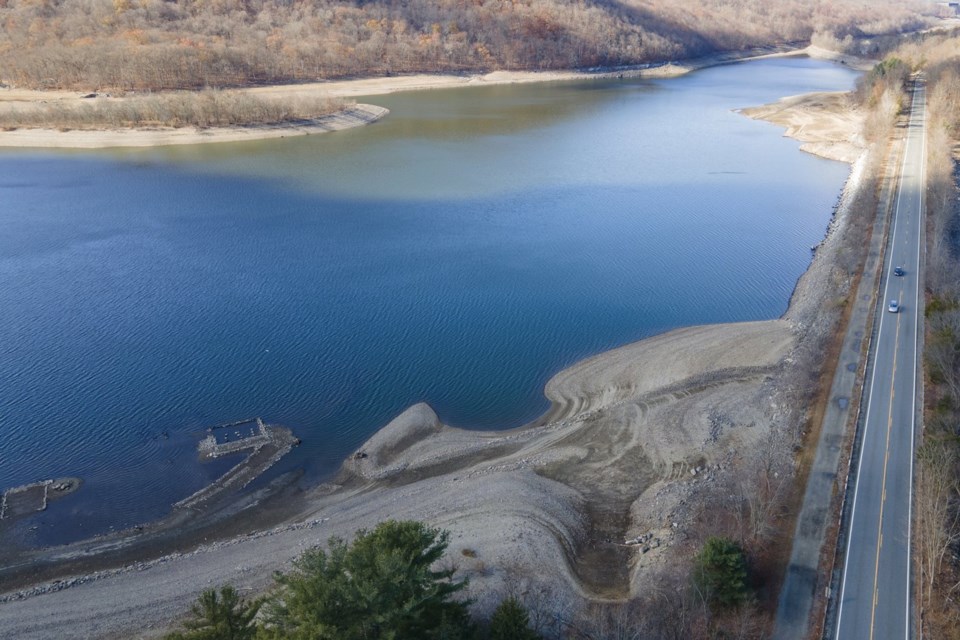BRICK, N.J. (AP) — With burning after its driest September and October ever, New Jersey will issue a drought warning, a step that could eventually lead to mandatory water restrictions if significant rain doesn't fall soon.
The state Department of Environmental Protection held an online hearing Tuesday on the conditions. But they would not answer questions, including whether any part of the state is in danger of running out of drinking water or adequate water to , which are burning in nearly a half-dozen locations. The Associated Press left a message seeking comment from the department after the meeting.
About an hour after it concluded, the department announced a press briefing for Wednesday “to discuss the state entering Drought Warning status as prolonged dry periods continue statewide.”
The New Jersey Forest Fire Service says conditions in the state are the driest they have been in nearly 120 years.
State geologist Steven Domber said water levels are declining across New Jersey.
“They are well below long-term averages, and they're trending down,” he said. “They will continue to drop over the coming weeks unless we get significant rainfall.”
He said about half the public water systems in New Jersey are experiencing close to normal demand for water, but 40% are seeing higher demand than usual.
It could take 10 inches (25 centimeters) of rain to meaningfully improve conditions in New Jersey, officials said. But forecasts don't call for that.
The combination of higher than normal temperatures, severely diminished rainfall and strong demand for water is stressing water supplies, said David Robinson, the state climatologist. He said New Jersey received 0.02 inches (a half-millimeter) of rain in October, when 4.19 inches (10.64 cm) is normal.
So far in November, the state has gotten a quarter to a half-inch (1.27 cm) of rain. The statewide average for the month is 4 inches (10.16 cm).
Since August, the state received 2 inches (5.08 cm) of rain when it should have gotten a foot (0.3 meters), Robinson said.
“A bleak picture is only worsening,” he said.
The state was under a drought watch Tuesday morning, which includes restrictions on most outdoor fires and calls for voluntary conservation. The next step, which the state is considering, a drought warning, imposes additional requirements on water systems, and asks for even more voluntary water-saving actions. The final step would be declaration of a drought emergency, under which businesses and homes would face mandatory water restrictions.
Several leaders of public water systems urged New Jersey to go straight to a drought emergency. Tim Eustace, executive director of the North Jersey District Water Supply Commission, said the Wanaque Reservoir is at about 45% of capacity.
“Using drinking water to water lawns is kind of crazy,” he said. “I would really like to move to a drought emergency so we can stop people from watering their lawns.”
New Jersey has been battling numerous wildfires in recent weeks, including at least five last week. The largest has burned nearly 5 1/2 square miles (14.24 square kilometers) on the New Jersey-New York border and led to the death of a . That fire was 20% contained as of Tuesday morning.
Conditions are also dry in New York, which last week. Mayor Eric Adams mayor urged residents to take shorter showers, fix dripping faucets and otherwise conserve water.
Just 0.01 inches (0.02 cm) of rain fell last month on the city’s Central Park, where October normally brings about 4.4 inches (11.2 cm) of precipitation, National Weather Service records show. City Department of Environmental Protection Commissioner Rohit Aggarwala said it was the driest October in over 150 years of records.
Jeff Tober, manager of Rancocas Creek Farm in the bone-dry New Jersey Pinelands, said his farm has gotten 0.6 inches (1.52 cm) of rain in the last 87 days.
“It’s been pretty brutal,” he said.
___
Follow Wayne Parry on X:
Wayne Parry, The Associated Press




